Should we worry about toenails?
She may earn a lot of money and be our new British hopeful, but Emma Raducanu is but human. “It’s not just my foot, my shoes; they’ve been sliding around a lot.” Thanks to Emma I have written an article that offers some self-help advice for sportspeople. It would appear from this Daily Telegraph report on 14th April (2022) that this started as a niggle at a prior event. The revelation of having no toenails might sound cosmetic but it can be far from a joke.
This article includes a printable advice sheet.
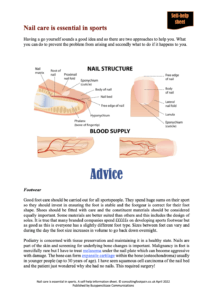
The Guardian and The Daily Mail picked up the story, which is considered highly interesting. By the end of the day, another digital report came out; despite her “latest physical ailment”, she won her latest match against Tereza Martincova in the Billy Jean King Cup singles. A sigh of relief and, of course, now the suggestion – who needs nails anyway? Of course, days later, we learned that Emma lost the next match to Marketa Voundrousova 6-1,6-1.
Now, you may not be into tennis or another sport, but it all comes down to the same thing. Feet contact with the ground in shoes and foot problems happen!
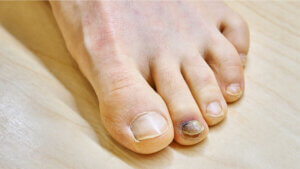
A single (second toe) nail is damaged with a haematoma. Longer toes are more prone to damage.
Do we need nails?
The nail in humans is often considered vestigial—in other words, through generations, it has lost its original function, like the opposable big toe. In the animal world, nails are tools and weapons. Primates rely on nails for some actions, but for humans, it is in the hand that nails retain a high value.
In truth, we can lose all our nails and not suffer. This is a common procedure for podiatrists. Podiatrists remove diseased nails and can prevent them from returning permanently.
Pressure gives rise to pain, and the end of the toe and nail bed are packed with pressure-sensory nerves for a good reason. The toe is our radar when it comes to touch, and we can work out hot, cold, deep, and light pressure. So, toes, together with their nails, are packed with sensors that tell us how much we hurt when stubbed.
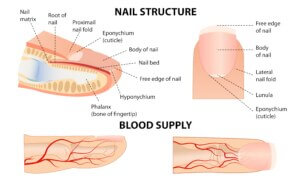
Click below on the link for my self-help article and quality diagram of the nail.
The nail is made of protein bonded in three layers and grows from a point below the ‘quick’ or ‘lunar’ area (lunule) demarcated in healthy toes and fingers by a half-moon shape. This is paler compared to the remaining pink nail bed. The illustration provides an idea of the complex anatomy, showing the blood supply and nail matrix, which contains the growing cells for the nail. The matrix is very sensitive to damage.
What is foot pistoning?
This is where the shoe is slightly too large, and the foot moves backwards and forwards with movement into the toe box, where damage can arise from impact forces.
My SELF-HELP guide article covers “nail care is essential in sports” and includes links and a video on how to release blood from a nail.
The Sports Angle
In sports, the foot must fit around the heel snugly. Unlike most people, the foot becomes very warm and can sweat and slip around if not secure in the shoe. The foot pistons into the front toe box end, and damage soon arises. It should be noted that friction and shear forces come into play, and the skin is also prone to blisters due to excess foot movement. This follows the idea that for ‘every action there is a reaction’ (another Newton Law of motion), the toe kicks the shoe and the shoe kicks back. Guess who loses?
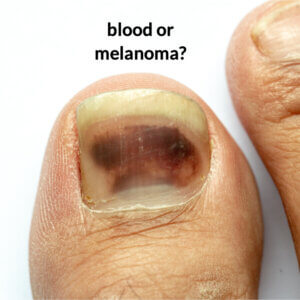
The natural competitive nature of high-level sports means minor injury can be tolerated until after the competition ceases, when pain escalates, and the damage is done. Podiatry is the only profession that manages nails and their structure as a dedicated speciality.
Distinct from pedicures, we focus on tissue preservation, pain, and deformity allied to medical problems. Today, podiatrists are very keen to screen for nail bed cancers, foreign bodies, and bone spurs.
Damaging effects on feet
Two features arise with the buffering of the toe. The joints and nail bed are compressed with constant forces. Our body weight exerts greater forces once we stand and move (Newton’s second law of motion). The forces at rest increase with motion (acceleration), and when we move quickly, we come off our heel and go onto the toes for longer. This is true for sprinters, but the toe pressure is still immense for the tennis player as they reach up to serve and then twist and turn, rotating across the ball of the foot.
The nail bed (haematoma)
The nail is damaged at the edge (hyponychium), and the sensitive connection is broken, causing the nail bed to bleed and lift the nail. If not released urgently, the blood turns black. The blood clot adds to the existing pressure lifting the nail and leads to chronic damage.
Emma’s nails were damaged previously, so the renewed injury worsened matters. The nail may thicken and attract mycotic infection (fungal) in the long term. The colour changes to a darker yellowing because there is no longer a tight connection between the nail bed and the nail plate, but infectious pigments also cause it.
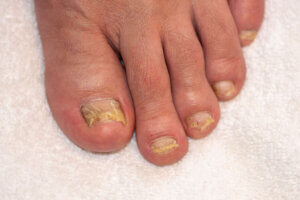
Long-standing effects from toenail damage (a fungal or mycotic infection)
Toe joint deformity
The small toe joint receives a similar insult due to impaction forces and, over time, will scar and may deform into a mallet toe or hammertoe position. If the nail or joint continues to be insulted, its quality will alter and age prematurely. When small toe joints become stiff, they transfer pressure to the skin, forming blisters, calluses, corns, and cysts. Those with such deformities suffer the effects of chilling and chilblains in the long term.
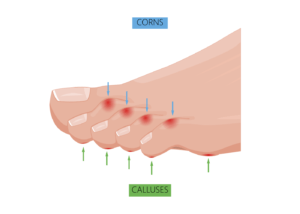
Nails undoubtedly carry humour, and why not? We need plenty to laugh at, but there is a downside, and that is to ignore the nail as harmless in the face of injury. The foot remains hidden, as does the profession of podiatry, but modern-day podiatry acts as the night watchman for the GP—now a diluted service following the pandemic.
Well, we can only hope Emma continues to do well on the circuit and thank her for bringing this news, although a little unsavoury. In the meantime, here is some advice for managing these problems: nail care is essential in sports. Also, you can read “Pain and Prevention of blisters“
Download my article on self-help for nail injury management and prevention
Thanks for reading “Tennis Player Loses Her Toenails” by David R. Tollafield
You can now read Foot Health Myths Facts & Fables by David R Tollafield, published at Amazon books.
Published by Busypencilcase Communications Est. 2015 for ConsultingFootPain

16 April 2022. Updated August 2024
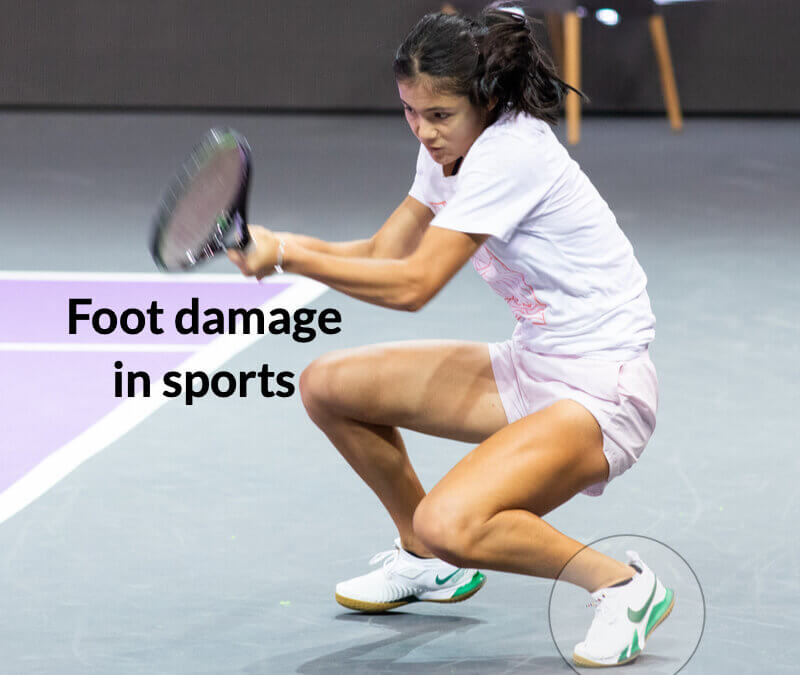
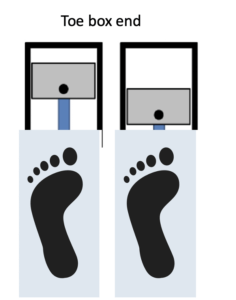
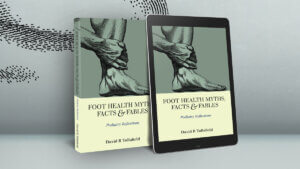
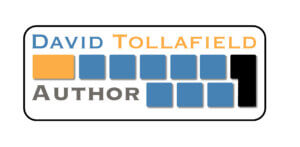
Trackbacks/Pingbacks